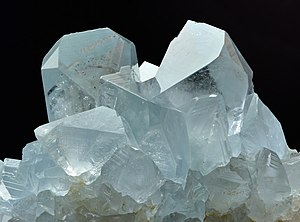User:MRaimondi
Jump to navigation
Jump to search
~HOLA~
Stuff I like
|
Hello, My name is Marcus. I am 15 and I go to the Gwinnett School of Mathematics, Science, and Technology. I have used wikipedia extensively. I used to edit alot but... I forgot my old account. Now, i am just getting back into wikipedia. I still have alot to learn and I want to continue improving wikipedia.
Celestine is a mineral consisting of strontium sulfate (SrSO4). It is named for its occasional delicate blue color. Celestine and the carbonate mineral strontianite are the principal sources of the element strontium, commonly used in fireworks and in various metal alloys. The mineral occurs as crystals, and also in compact massive, and fibrous forms. It is found worldwide, mostly found in sedimentary rocks, usually in small quantities. Pale blue crystal specimens, as shown in this photograph, are found in Madagascar.Photograph credit: Ivar Leidus
 ERIS IS AWESOMER THAN MOST THINGS EXCEPT A FEW . Hubble Space Telescope. | |||||||||
| Discovery | |||||||||
|---|---|---|---|---|---|---|---|---|---|
| Discovered by | M. E. Brown, C. A. Trujillo, D. L. Rabinowitz[1] | ||||||||
| Discovery date | October 21, 2003[1] | ||||||||
| Designations | |||||||||
Designation | 136199 Eris | ||||||||
| 2003 UB313[2] | |||||||||
| dwarf planet TNO (scattered disc object) | |||||||||
| Orbital characteristics | |||||||||
| Epoch March 6, 2006 (JD 2453800.5)[3] | |||||||||
| Aphelion | 97.56 AU 14.60×109km | ||||||||
| Perihelion | 37.77 AU 5.65×109 km | ||||||||
| 67.6681 AU 10.12×109 km | |||||||||
| Eccentricity | 0.44177 | ||||||||
Average orbital speed | 3.436 km/s | ||||||||
| 197.63427° | |||||||||
| Inclination | 44.187° | ||||||||
| 35.8696° | |||||||||
| Known satellites | 1 | ||||||||
| Physical characteristics | |||||||||
Equatorial radius | 1,200 ± 50 km 0.19 Earths | ||||||||
| Mass | (1.66 ± 0.02)×1022 kg[4] | ||||||||
Mean density | 2.3 g/cm3 | ||||||||
| ~0.8 m/s2 | |||||||||
| > 8 h? | |||||||||
| Albedo | 0.86 ± 0.07 | ||||||||
| |||||||||
| 18.7 | |||||||||
| −1.12 ± 0.01 | |||||||||
- ^ a b Staff (May 1, 2007). "Discovery Circumstances: Numbered Minor Planets". IAU: Minor Planet Center. Retrieved 2007-05-05.
- ^ Staff (February 29, 2004). "Minor Planet Designations". IAU: Minor Planet Center. Retrieved 2007-05-05.
- ^ Asteroid Observing Services
- ^ M.E. Brown and E.L. Schaller (2007). "The Mass of Dwarf Planet Eris". Science. 316 (5831): 1585. doi:10.1126/science.1139415.
